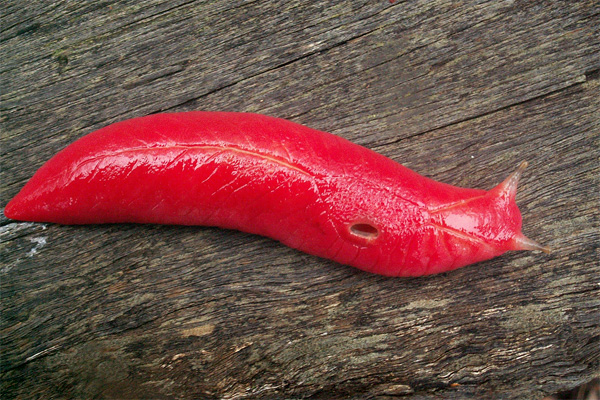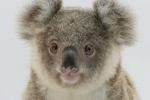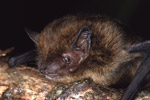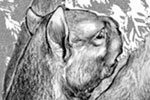Hot pink slugs that emerge after rainy nights have become a conservation symbol for alpine forests on Australia’s Mount Kaputar, reports The Sydney Morning Herald.
The slugs, which measure up to 20 centimeters (8 inches), are only found on Mount Kaputar, a volcano that last erupted 17 million years ago. They spend most of their time buried under leaf litter, but emerge by the hundreds when conditions are right to feed on moss, algae, and fungi. While their fluorescent coloration may seem jarring, it actually helps them blend in with brightly-colored eucalyptus leaves that cover the forest floor.
The slug, Triboniophorus aff. graeffei, shares its habitat with carnivorous land snails that are also unique to the mountaintop, according to recent research. Based on the presence of the species and the uniqueness of the ecosystem, which represents a remnant of a type of forest that once covered much of eastern Australia, but disappeared once Australia separated from the supercontinent Gondwana some 180 million years ago, the New South Wales Scientific Committee recently moved to list the site as an “endangered ecological community”, granting it the highest level of protected status.

Photo by Michael Murphy of the National Parks and Wildlife Service
“The endemic species that are restricted to the moist refugia of higher elevations in the Mount Kaputar area are of particular concern. These species have evolved from lowland ancestors and have been isolated in an otherwise snail-hostile environment as conditions began to dry,” stated the committee’s report. “As a result they are acutely susceptible to the modifications in habitat structure and distribution that are likely to occur in the future.” These include rising temperatures, shifts in rainfall, changes in fire regimes wrought by human-induced climate change, according to the report.

Photo by Michael Murphy of the National Parks and Wildlife Service
The giant hot pink slugs and other inhabitants of Mount Kaputar aren’t the only Australian species at risk from climate change and other human impacts. A 2011 study led by William F. Laurance of James Cook University identified several habitats whose species could be particularly vulnerable to increased drought and higher temperatures. For example, the white lemuroid possum (Hemibelideus lemuroides) is found only in the cool, cloud forests above 1,100 meters on Mount Lewis in northern Queensland, a habitat that’s rapidly changing due to climbing temperatures. Some researchers argue that Australia’s marine species also face an uncertain near-term future. Rising temperatures and increasing ocean acidification could doom many of the dominant coral species that currently make up the Great Barrier Reef.

View from lookout in Mount Kaputar National Park. Photo by Rob Cleary of the National Parks and Wildlife Service
REFERENCES
- Michelle Leishman (2013). Preliminary Determination on the the Mount Kaputar high elevation and vine thicket land snail and slug community in the Nandewar and Brigalow Belt South Bioregions. NSW Scientific Committee. May 17, 2013.
- William F. Laurance et al (2011) The 10 Australian ecosystems most vulnerable to tipping points. Biological Conservation 144, 1472-1480.
Related articles
Scientist: Australia taking ‘calculated actions’ to push Leadbeater’s possum to extinction

(06/06/2013) Australia’s leading scientific expert on the endangered Leadbeater’s possum has publicly lambasted the Victorian state government, claiming it is the first ever domestic administration to take “calculated actions” that it knew could wipe out a threatened species. In a letter published in the respected journal Science, Prof David Lindenmayer, of the Australian National University, states that “government-sanctioned legal logging of the reserve system will significantly increase the chance of extinction of Leadbeater’s possum.”
Forests under fire: Australia’s imperiled south west

(03/05/2013) In the far southwestern corner of Western Australia, beyond the famed wineries in the shadow of the Margaret River, lies an ecosystem like no other, the South West ecoregion. This part of Australia has been identified as one of 34 global biodiversity hotspots, home to rare endemic flora and fauna like the Carnaby’s black cockatoo, numbat (banded anteaters), woylie (brush-tailed bettong), mainland quokka and over 1500 plant species, most found nowhere else. Unfortunately, this unique habitat is being increasingly fragmented and its inhabitants threatened by a number of forces, including climate change, dieback, fires and logging. And, on the eve of the Western Australia’s state elections, the future of the South West hangs in the balance.
Cute koalas have become ‘urban refugees’

(01/28/2013) According to Susan Kelly, koalas have become “urban refugees,” under siege by expanding cities that bring with them deforestation, dogs, traffic, and other ills for native wildlife. Director of Global Witness, and writer, producer and director of the new documentary Koala Hospital, Kelly has spent 3 years working to understand the rising threats to one of the world’s most beloved marsupials. While Koala Hospital highlights the many perils facing koalas, including climate change due to record fires across Australia, it also looks at the efforts of individuals who work to save koalas one—by—one at Port Macquarie Koala Hospital, taking in patients who have been orphaned, hit by cars, scarred in fires, or attacked by dogs.
Great Barrier Reef loses half its coral in less than 30 years

(10/01/2012) The Great Barrier Reef has lost half of its coral cover in the last 27 years, according to a new study released today in the Proceedings of the National Academy of Sciences (PNAS). Based on over 2,000 surveys from 1985 to this year the study links the alarming loss to three impacts: tropical cyclone damage, outbreaks crown-of-thorns starfish that devour corals, and coral bleaching.
Island bat goes extinct after Australian officials hesitate

(05/23/2012) Nights on Christmas Island in the Indian Ocean will never again be the same. The last echolocation call of a tiny bat native to the island, the Christmas Island pipistrelle (Pipistrellus murrayi), was recorded on August 26th 2009, and since then there has been only silence. Perhaps even more alarming is that nothing was done to save the species. According to a new paper in Conservation Letters the bat was lost to extinction while Australian government officials equivocated and delayed action even though they were warned repeatedly that the situation was dire. The Christmas Island pipistrelle is the first mammal to be confirmed extinct in Australia in 50 years.
Humans killed off magnificent Australian megafauna, flipping rainforest into savannah

(03/27/2012) The theory that humans, and not climate change, was primarily responsible for the extinction of giant marsupials in prehistoric Australia takes another step forward with a new study in Science. Exploring sediment cores for past evidence of big herbivores, researchers found that the arrival of humans coincided with the loss of a menagerie of magnificent beasts, from giant kangaroos to fearsome marsupial lions and monster birds to Komodo dragon-like reptiles. The decline of this megafauna ultimately led to ecological changes that may have caused Australia’s rainforest to become savannah.
Kangaroos at risk from climate change
(10/16/2008) A 2°C-rise in temperature could trigger significant range contraction for kangaroos in Australia and put one species at high risk of extinction, reports research published in the December issue of Physiological and Biochemical Zoology.
(08/12/2007) The Aldabra banded snail (Rachistia aldabrae), a rare and poorly known species found only on Aldabra atoll in the Indian Ocean, has apparently gone extinct due to declining rainfall in its niche habitat. While some may question lamenting the loss of a lowly algae-feeding gastropod on some unheard of chain of tropical islands, its unheralded passing is nevertheless important for the simple reason that Rachistia aldabrae may be a pioneer. As climate change increasingly brings local and regional shifts in precipitation and temperature, other species are expected to follow in its path.
Coral reefs decimated by 2050, Great Barrier Reef’s coral 95% dead
(11/17/2005) Australia’s Great Barrier Reef could lose 95 percent of its living coral by 2050 should ocean temperatures increase by the 1.5 degrees Celsius projected by climate scientists. The startling and controversial prediction, made last year in a report commissioned by the World Worldwide Fund for Nature (WWF) and the Queensland government, is just one of the dire scenarios forecast for reefs in the near future. The degradation and possible disappearance of these ecosystems would have profound socioeconomic ramifications as well as ecological impacts says Ove Hoegh-Guldberg, head of the University of Queensland’s Centre for Marine Studies.